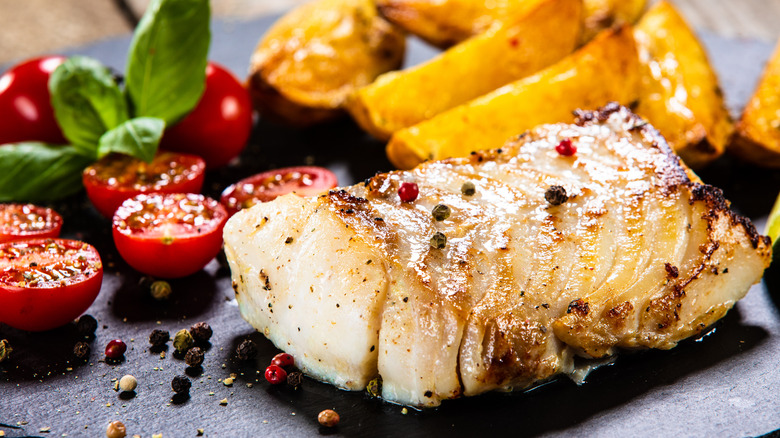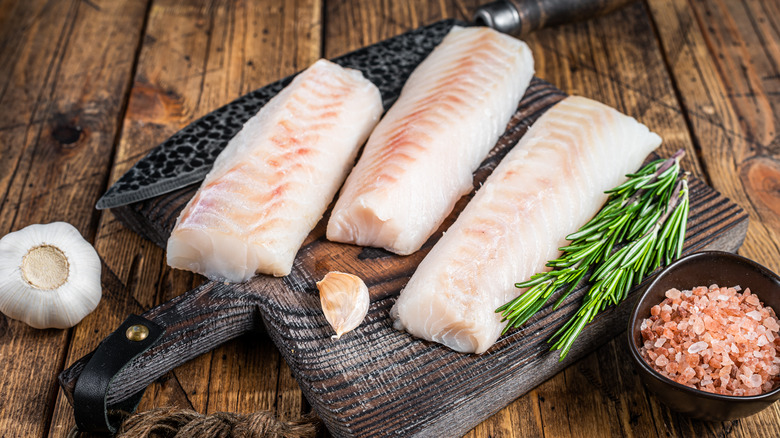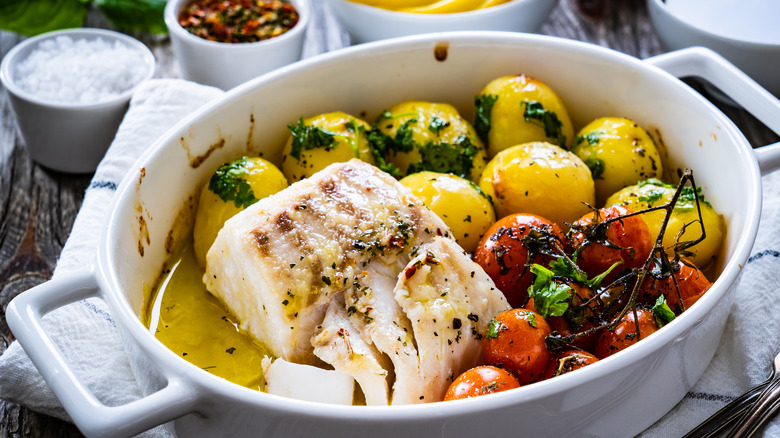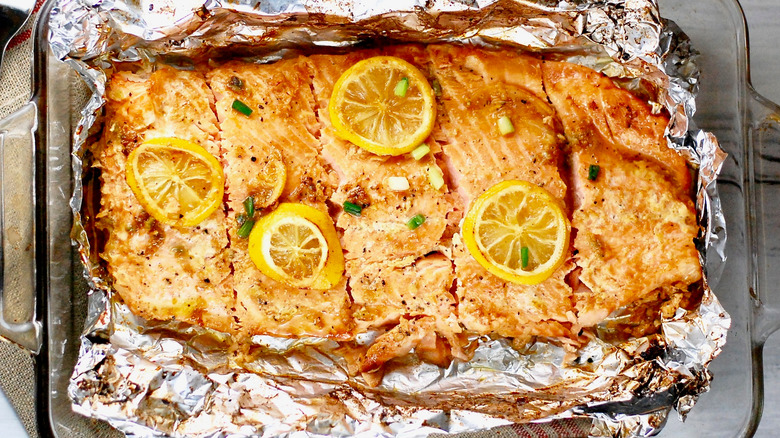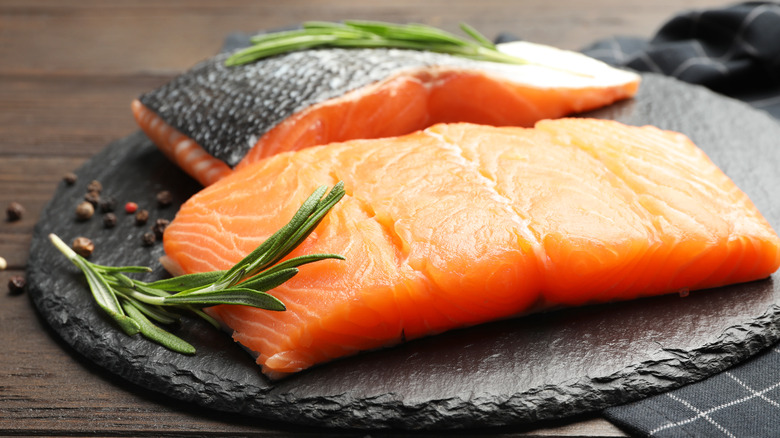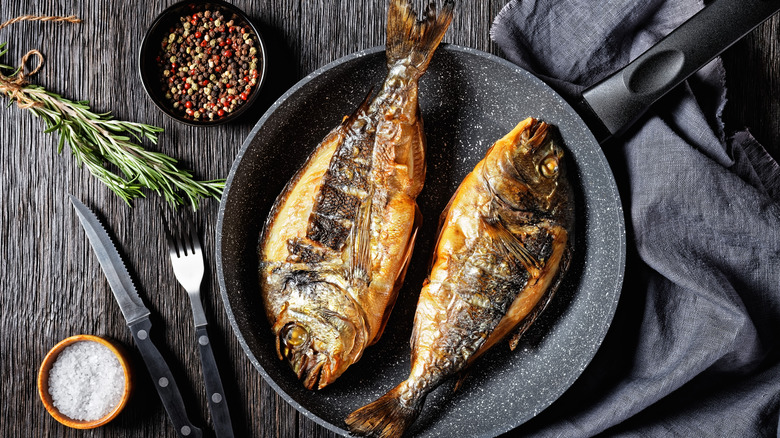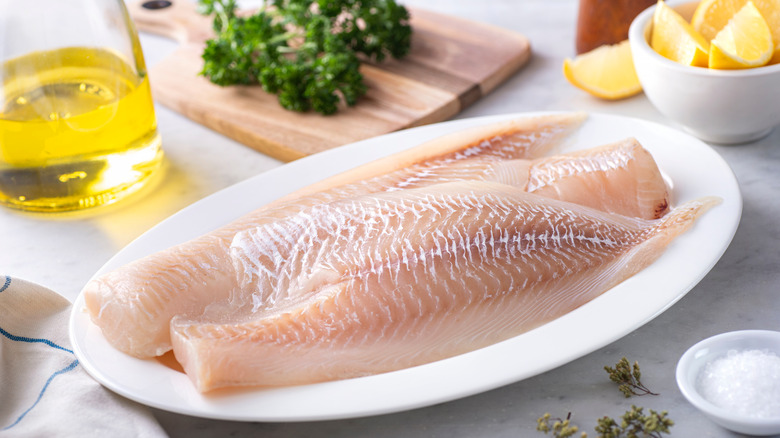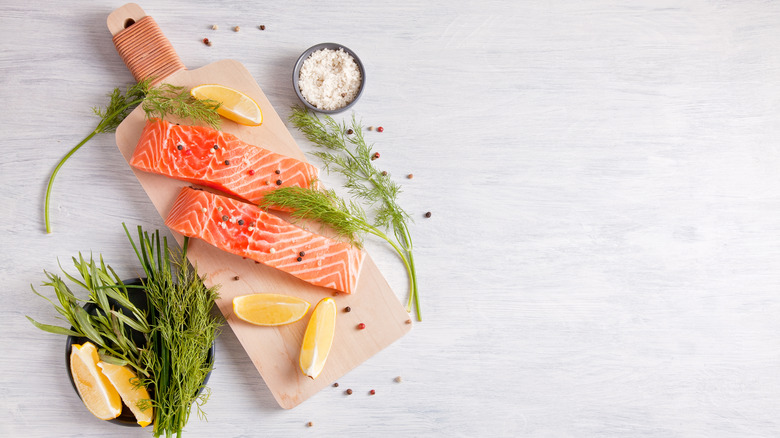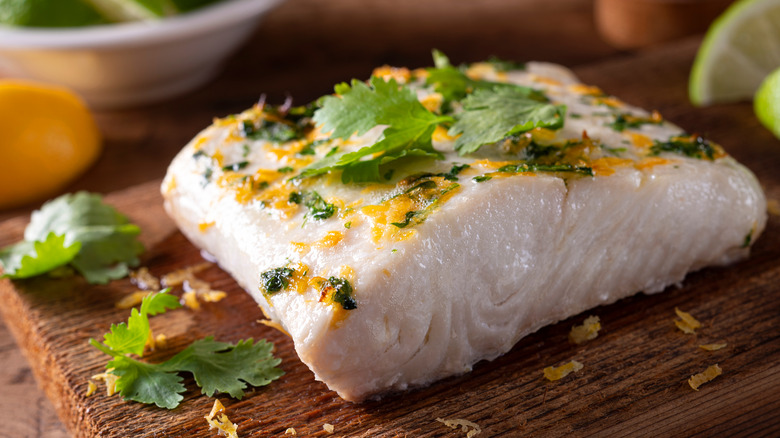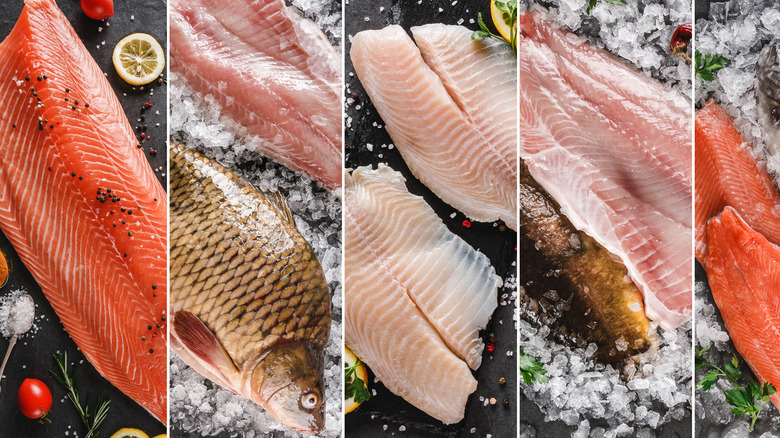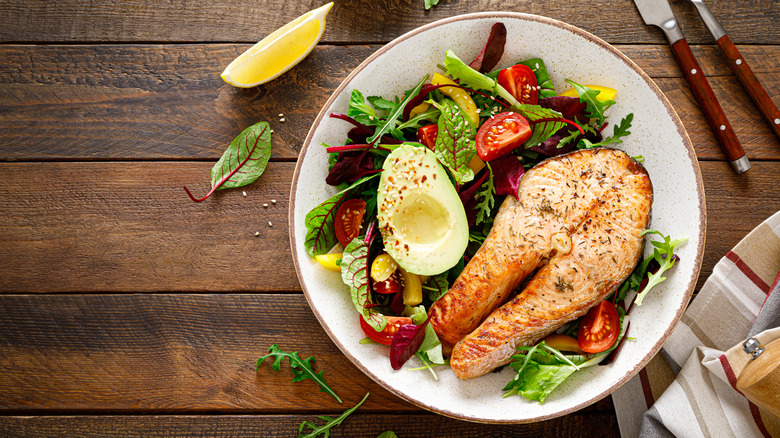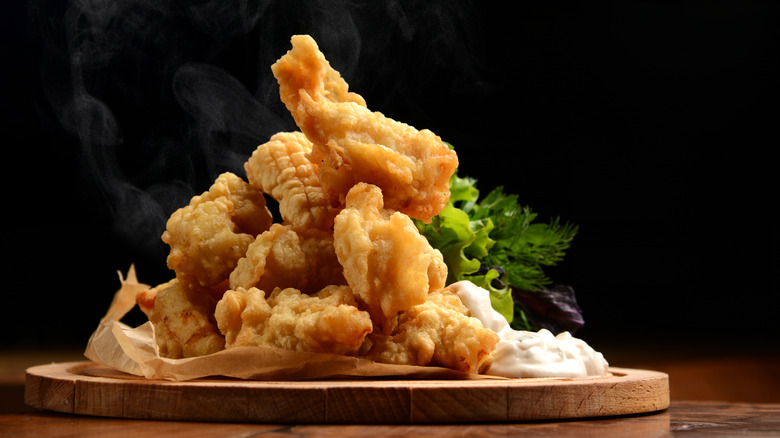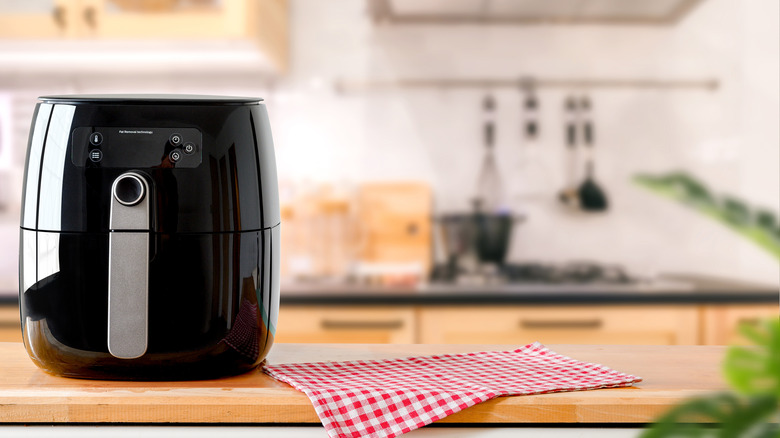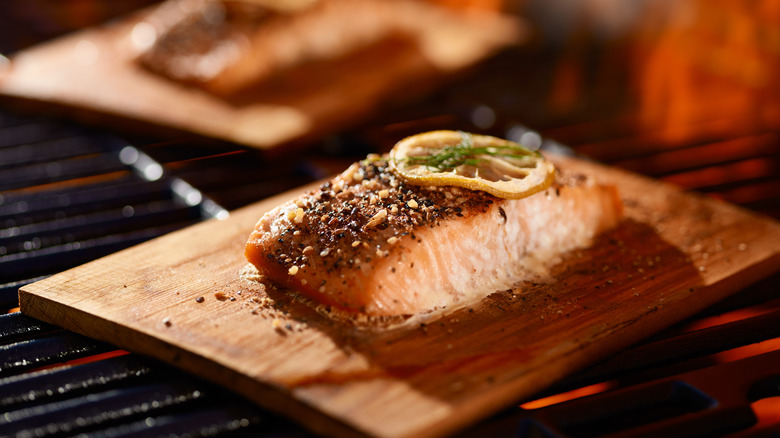Tips You Need When Cooking With Fish
There seem to be as many ways to prepare fish as there are actual fish in the sea. From baked to stuffed to fried (with a side of chips, of course), you could try a new fish recipe every week and it would take ages to run out of ideas. Not to mention, consuming fish may offer you several health benefits, including a healthy heart, supported brain function, inflammation prevention, and decreased risk of Alzheimer's disease, according to the Washington State Department of Health.
However, whether your recipe calls for salmon, snapper, trout, or tuna, fish can be finicky in the kitchen. Home chefs often struggle with a variety of issues whether it's the delicate, flaky flesh falling apart on the grill and sticking to skillets, failing to get the skin nice and crispy, or overcooking their precious catch. The following tips will ease your fish-preparation woes so you can enjoy cooking your meal without any added stress.
Follow the 10-minute rule
Beef has no poker face when it comes to doneness: as the meat cooks, its red color will turn brown. While it's easy to spot that progression with tuna and swordfish, tracking the cook will be much trickier with several types of fish, especially white fish, as the color change is nonexistent or minuscule. If only there were a tried-and-true rule for timing out fish cooking, right? Here's some good news: there is.
Many cooks swear by the 10-minute rule, a method of cooking fish in which you add 10 minutes of cooking time for every inch of the fish's thickness (via City Fish Market). So, a 1-inch-thick fish fillet would cook for 15 minutes. What makes this foolproof trick even easier is it can be used whether you're baking, grilling, steaming, or smoking your fish. It doesn't get any simpler than that.
You may be wondering how this rule applies to an uneven fillet; The New York Times suggests sticking to the less is more philosophy. Undercooked fish can be thrown back on the heat, but doneness is permanent — and if you're feeling really stumped, just keep your meat thermometer handy and check if the thickest part of the fish has reached 145 F.
Know when to add moisture
Few bites are better than buttery, flaky cod that somehow melts in your mouth and bursts with flavor at the same time. But a dry bite of fish that sits on the tongue like sawdust is a recipe for disappointment.
That's why you want to keep your lean fish hydrated by baking it in a shallow pool of liquid or sauce, such as wine, butter, milk, water, citrus juice, or any mixture of the former to your tastebuds' content (via Help With Cooking). Depending on how much fish you're making and the ingredients, you can get your fish Jacuzzi going in a braising dish, cookie sheet, or foil.
If you are preparing an oily fish, like salmon, trout, or herring, bake the fish on a rack atop a cookie sheet so it's not swimming in juices. The result will be an evenly-cooked but not overly soggy fillet. You can still put a mix of wine, butter, and other flavor staples in the baking sheet if you'd like — this will allow the fish to bask in the simmering aromas of the liquid below without becoming oversaturated.
Use foil wisely
To foil or not to foil? When serving up fish, that is always the question. Covering a fish with foil during a dry cook like baking or grilling will shorten cooking times (via LeafTV) — but with a piece of meat that takes a mere half-hour or less to cook, when is speeding up the process necessary? On the other hand, a foil cover will trap moisture in and essentially steam the fish, leading to a more moist fillet in the end.
Another pro-foil argument is the ease in clean-up; lining your pan with foil means no dreaded stuck-on fish bits to scrub off (but the rest of our tips should help prevent that in the first place). Form the foil like a pocket around the fish if you choose to use this method to ensure the juices and marinades don't run out. This will keep your fish in a nice, steamy sauna too.
But if you'd prefer a golden-brown, crispy fish, leave it to the open oven air. The Cooking Bar suggests keeping the foil off will allow this texture to take form, rather than trapping excess moisture in the fish. This is the preferred method for breaded fish in order to prevent a soggy crust.
Fish skin for the win
Not all fish skins are created equal. While tuna, skate, monkfish, and swordfish skins are either too tough or just not tasty enough to justify keeping on, there are several options such as salmon, sea bass, branzino, mackerel, and snapper with a delicious, easy-to-eat skin. For those varieties, keep the skin intact and not just not just for a flavor boost.
According to The Better Fish, fish skin contains a significant amount of omega-3 fatty acids, the white knight ingredient of many kinds of seafood, which provides many health perks from helping your help to dealing with inflammation. Fish skin will also become delightfully crispy when seared, a great contrast to the soft, tender fish itself. However, there are certain forms of cooking that won't crisp up the skin at all, like steaming or poaching, Chef Mark Usewicz tells Epicurious. If soggy skin doesn't seem appetizing, opt for a skinless filet in those instances.
Another Usewicz tip: Make sure your fish skin is thoroughly dried before cooking to ensure crispiness. A sprinkle of salt may help dehydrate the skin, but be careful to keep those crystals away from the actual fillet meat.
Preheat your skillet if pan-frying
Don't give fish the cold shoulder when pan-frying. The last thing you want your pricey piece of halibut to do is to stick to the pan, turning a beautiful fillet into a flaky fiasco. You can avoid this potential dinner party tragedy by generously coating the skillet with a high-smoke oil (we love avocado oil for fish) and letting it preheat before cooking your fish.
Reluctant Gourmet explains why this is necessary: Fish is very high in protein, and proteins cling hard to surfaces when they denature, which is exactly what happens when it comes into contact with heat. Your pan should be hot enough that the proteins cook too quickly to stick. Simply heat your pan to medium-high heat until a few drops of water in the pan would boil and evaporate immediately. Be sure to bring your fish out of the refrigerator 15 to 30 minutes before cooking. Chilled meat will bring the temperature of the pan and oil down.
Also, contrary to timeworn rumors, delicate fish can be successfully cooked in cast iron. Just be sure to heat and grease the skillet, being very forthcoming with the oil if your iron isn't thoroughly seasoned. If your cast iron has a nice, established seasoning, you should have no problems nailing a gorgeously seared and crusted fish.
Pat fish dry before cooking
The only time fish need to be swimming in water is when they're ... well, swimming in water. Before you start loading up your fish with seasonings and spices, you'll want to dry off any excess moisture to prevent the flesh from getting mushy.
According to Legendary White Tails, fish that hasn't been dried will start to steam instead of sear when it hits a hot surface. If your fish fillet is pale and limp off the skillet, it was likely too moist when it entered the pan. You can also keep your fish skin-up uncovered in the fridge for an hour before you plan to cook it to draw moisture out of the skin (via Foodie and the Chef).
Legendary cautions against using salt to dry out delicate seafood — you don't extract too much moisture. When using a salt-based seasoning on a fish fillet, don't let the seasoning sit too long on the meat before cooking begins.
Only flip fish once
There's no easier way to make a piece of fish fall apart than to constantly get your spatula under it. If you want to keep your fragile salmon steak intact, the best thing you can do is to flip it just once during the cooking process, says seafood cookbook author and New York-based fishmonger Joe Gurrera (via WPR). Since fish tends to be delicate, it will fall apart the more it's tossed and turned.
So when should the singular flip happen? According to City Fish Market, halfway through the cooking time will do. So, if you are cooking a one-inch-thick fish for 10 minutes, you should flip it after five minutes of cooking. This applies to any method of cooking where you'd flip fish, including skillet-frying and grilling. If you like a cooked-golden fish with a delicious crust on the outside, only flipping the fillet once will be your secret weapon.
Season fish with herbs and citrus
Picking the right seasoning for seafood can be tricky. Its flavor could be drowned out by garlic-heavy marinades, unlike the robust taste of beef that stands up to the aromatic affront. A slathering of barbecue sauce is welcome on chicken, but the sweet and tangy addition could taste strange on a delicate filet of fish. So, what spices and flavors will swim best with your fish entrée?
Citrus and citrus-like fruits are common fish companions, offering a light and tangy element to your dish. For your next fish-fueled soiree, consider topping your fillets with a bold, fruity garnish, such as a mango salsa or a preserved lemon chutney. Herbs like dill, turmeric, cumin, and ginger are also often along for the ride. Fresh herbs, in particular, provide a welcome earthiness.
If you insist on going in a garlicy direction, consider changing the way the bulb is incorporated; garlic powder, finely-chopped, or minced garlic is going to be much stronger in flavor than sliced fresh garlic laid over a fillet, or whole garlic cloves tossed in the baking pan or skillet.
Marinate fish before cooking on high heat
We've all groaned at fish coming off the grill looking more like a creature of the desert than one of the sea. If you're opting for a high-heat cooking method, like grilling, and are plagued by an unpleasant dryness to the fish, you can marinate your seafood to keep it juicier thanks to the excess moisture. The oils from the marinade just may prevent the pesky stickiness known to frustrate every fish lover as well, according to City Fish Market.
One perk of marinading seafood, besides the delicious flavor infusion, is that you don't have to worry about getting the fish soaking the night before. As CFM explains, seafood is very sensitive to acid-based liquids and will start to cook just from the vinegar or lemon juice in a marinade. You don't want your fish undergoing a low-grade cook overnight unless mushy, overdone fillets are what you're going for. A half-hour to a full hour is plenty to marinade a piece of seafood. One exception to this rule ceviche, where seafood is cured by marinading overnight in citrus juices, but is not mushy, overdone fillets
That said, some defy this rule — or at least find loopholes in it. LeafTV suggests opting for a saltless dry rub instead, or marinading your fish overnight sans the acidic ingredient. In that method, simply add the acid to the marinade just prior to cooking, let it all get acquainted for a few minutes, and you're good to go.
Know your fish flavors
We all know that one man's trash is another man's treasure and oceanic harvest offers no exception. A mild halibut fillet may be a bore to a lover of mackerel, a fish known for its intense ... well, fishy flavor. Whether surf is a new interest in your kitchen or you're just looking to expand your sea horizons, knowing just how aggressively a fish's flavor will attack your tastebuds is important in mastering the art of underwater cuisine.
If you'd prefer to not feel like you've taken a gulp straight out of the Atlantic when eating fish, consider milder varieties like tilapia, halibut, cod, mahi mahi, and swordfish (via Jasper White's Summer Shack). These options don't have as much of that abrupt, intense, oceanic flavor that may be polarizing to certain eaters. Because they're also often well-seasoned, battered, or served with a chutney or salsa garnish, you may find that the fishy taste is absent from these varieties altogether.
As a fish's fat content gets higher, so does its strong seafood flavor (via Hy-Vee). Herring, salmon, mackerel, sardines, and anchovies will feel like much more of an affront to your palate than the former, more delicate options. Some swear by methods to counteract or eliminate the concentrated flavor, most commonly the method of soaking the fish in milk (via Livestrong), which pulls out the chemical responsible for the strong seafood taste.
Double-check for pin bones
Imagine your friends are just sitting down at your dining table for a dinner party. You've been preparing all day for this get-together: great cocktails, delicious sides, and the main course, your prized recipe for baked salmon. But just as everyone digs in, something goes wrong ... a guest is hacking on a pin bone.
Pin bones are pesky pieces of cartilage so small they are impossible to perfectly detect and remove in the processing of salmonid fish types (via Processing Magazine). While swallowing a pin bone rarely causes damage more serious than a jabbed mouth or a scratch throat (via the University of Utah), their unwelcome pokiness is the last thing you expect when digging into a soft, juicy fillet of salmon.
Carefully checking your fish for bones will help prevent unpleasant surprises in your seafood plates and any consequential awkwardness at a dinner party. If you have no idea how to do this, we have a quick hack for removing pin bones from fish to make sniffing out those suckers a piece of cake. Simply turn a bowl upside-down on your counter and lay your fillet over the bowl. The convex angle pushes the pin bones out, making them easier to see and remove.
Don't crowd fish when deep frying
There are few meals more satisfying than a plateful of beer-battered cod, still sizzling with fryer grease, served with a heap of french fries and a cup of tartar sauce. It's a particularly delicious fish recipe for Lent (and all-around classic) that is sure to get any seafood fan's mouth watering.
But have you ever been presented with a mess of fried fish that got stuck together in the oil? Oftentimes when you break those pieces apart, you find a soggy, unappealing spot of raw batter. This common food frying mistake because too many pieces of battered fish were added to the fryer at once, causing the temperature of the oil to drop and resulting in a more uneven cook of the fish. The batter can't quickly crisp up and become golden brown, so as the crowded fish inevitably bump into one another, they stick.
Fortunately, preventing this at home is easy. Stick to only frying a couple of pieces at a time, and try to break up pieces that have stuck together. If you're worried about your fried fish going cold by the time you're done, you can either keep the fish warm in the oven or give everything one quick dunk back in the oil before you serve up your fish 'n' chips.
Don't underestimate your air fryer
Air fryers offer convenience in the kitchen and bring a healthier spin to the deep-fat-fried foods we hate to love. These gadgets are healthy, safer (no more cooking with hot oil means no more grease splatters to the face and hands), and infinitely more convenient. Among the many different ways to cook fish, air frying is a great bet. Feel free to use virtually any type of fish (except for freshly battered fish, but your frozen fish sticks are okay) and it will turn out just as crisped and delicious as traditional methods, with a minimal lingering fishy smell.
Air frying done right will deliver a fish that's juicy and flaky on the inside but caramelized and crisped on the outside. What's better is you'll be doing it in half the time and with half the cleanup. But if concerns about drying out your fish in this kitchen contraption still linger, there are steps you can take to prevent fish from drying out in the air fryer, including letting the machine preheat.
Grill or smoke fish on wood planks
As simple and light of a flavor that many fishes offer, they are great foundations to build rich, complex flavors on. A peppery seasoning or citrusy marinade is your first building block, and putting the fillet on the grill or smoker is the next one for that unbeatable fresh-off-the-grates taste. But if you're looking to really bring depth to your seafood's flavor, smoke it on wood.
Smoking or grilling fish on a cedar plank will unlock a delicious earthy and smoky flavor in the fish. The wood will emit smoke as it heats and burns, which will be absorbed by the fish. The flavor and smokiness of each plank will be distinct depending on what species of tree is used, just as they are in wood or pellet smokers.
You can also spritz your fish with an oil or other preferred liquid (if it wasn't marinated) right before laying it on the smoker or grill to maximize this added flavor. Smoke from the wood plank will be attracted to the meat's wet surface. Cedar is one of the most popular wood planks for grilling fish, but make sure it's food safe (going full lumberjack on the cedar tree next to your garage is not recommended).
